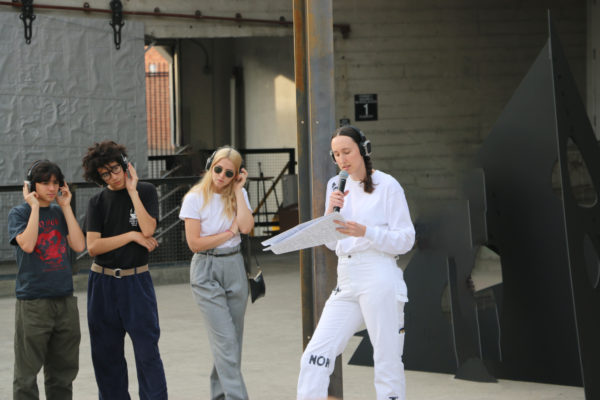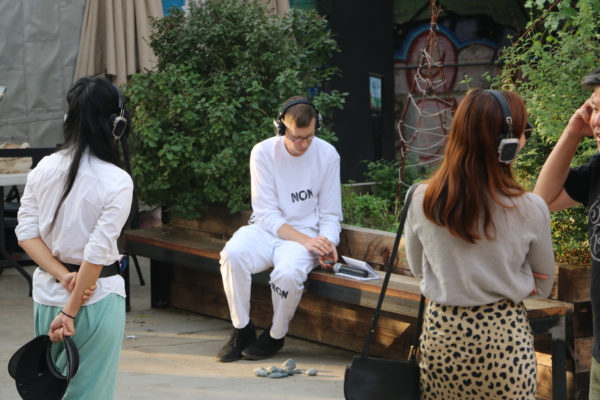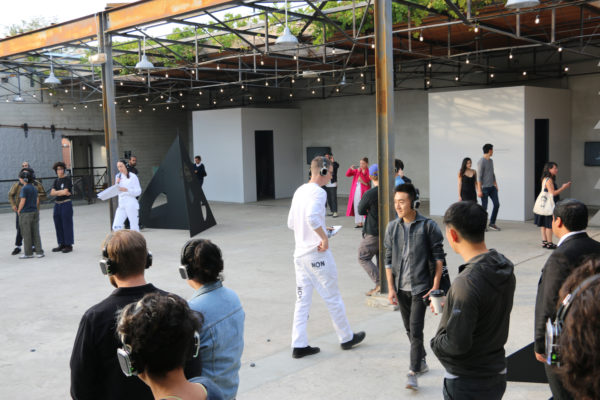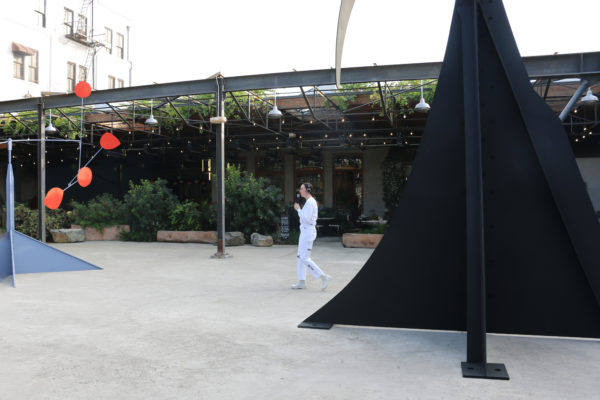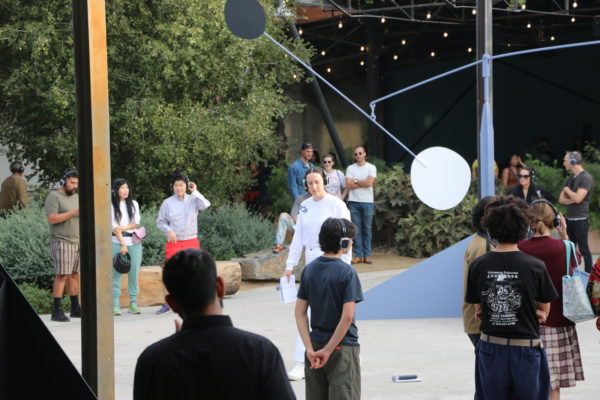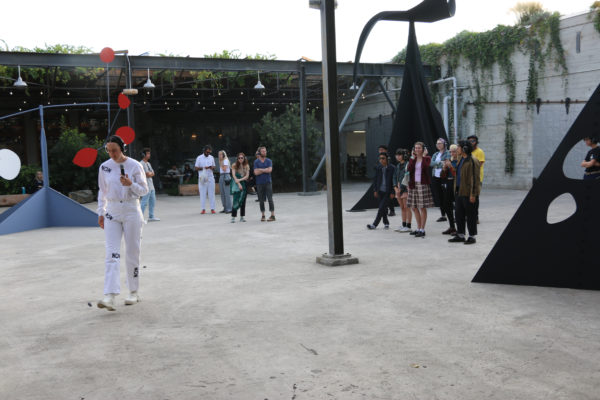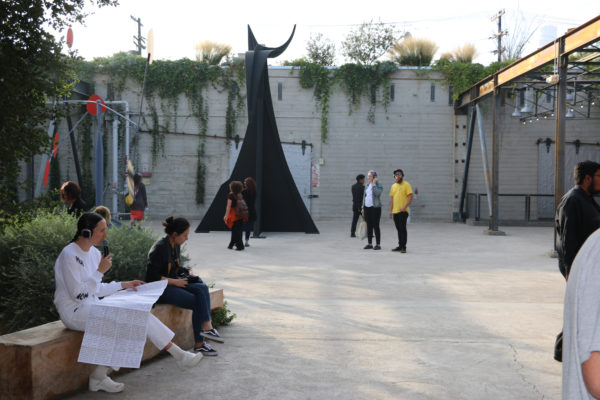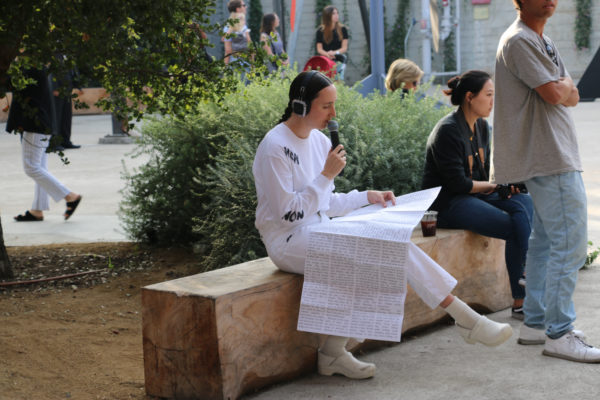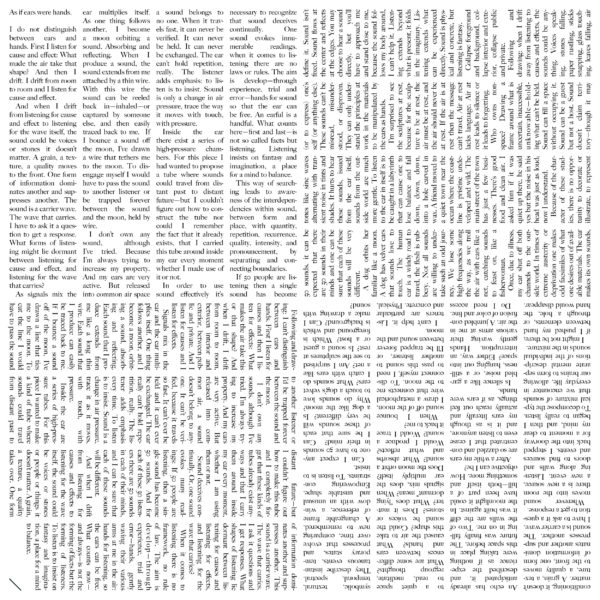Music that speaks to the theme of ‘nonspace’—where a provisional, variable structure is used as a frame for what is uncertain, inaccessible or unknowable; where sound may fill a space without occupying it. The audience, provided with wireless headsets, find the piece in multiple simultaneous ways, as they may choose: by listening directly to acoustic events happening in the space, or by selecting one of three different live-broadcast, processed versions of these events. Whether choosing to hear sounds directly, indirectly, or to avoid hearing altogether, listening becomes a way of extending what can be seen or experienced directly, collapsing foreground and background, interior and exterior, public and private. (a sample mix is included below)
As If Ears Were Hands
I do not distinguish between ears and hands. First I listen for cause and effect: What made the air take that shape? And then I drift. I drift from room to room and I listen for cause and effect.
And when I drift from listening for cause and effect to listening for the wave itself, the sound could be voices or stones it doesn’t matter. A grain, a texture, a quality moves to the front. One form of information dominates another and suppresses another. The sound is a carrier wave. The wave that carries. I have to ask it a question to get a response. What forms of listening might lie dormant between listening for cause and effect, and listening for the wave that carries?
As signals mix the ear multiplies itself. As one thing follows another, I become a moon orbiting a sound. Absorbing and reflecting. When I produce a sound, the sound extends from me attached by a thin wire. With this wire the sound can be reeled back in—inhaled—or captured by someone else, and then easily traced back to me. If I bounce a sound off the moon, I’ve drawn a wire that tethers me to the moon. To disengage myself I would have to pass the sound to another listener or be trapped forever between the sound and the moon, held by wire.
I don’t own any sound, although I’ve tried. Because I’m always trying to increase my property. And my ears are very active. But released into common air space a sound belongs to no one. When it travels fast, it can never be verified. It can never be held. It can never be exchanged. The ear can’t hold repetition, really. The listener adds emphasis: to listen is to insist. Sound is only a change in air pressure, trace the way it moves with touch, with pressure.
Inside the ear there exist a series of high-pressure chambers. For this piece I had wanted to propose a tube where sounds could travel from distant past to distant future—but I couldn’t figure out how to construct the tube nor could I remember the fact that it already exists, that I carried this tube around inside my ear every moment whether I made use of it or not.
In order to use sound effectively it’s necessary to recognize that sound deceives continually. One sound evokes innumerable readings. when it comes to listening there are no laws or rules. The aim is develop—through experience, trial and error—hands for sound so that the ear can be free. An earful is a handful. What counts here—first and last—is not so called facts but listening. Listening insists on fantasy and imagination, a place for a mind to balance.
This way of searching leads to awareness of the interdependencies within sound, between form and place, with quantity, repetition, recurrence, quality, intensity, and pronouncement, by separating and connecting boundaries.
If 50 people are listening then a single sound has become 50 sounds. it can be expected that there are 50 sounds in their minds and one can be sure that each of these sounds will be very different.
A dog orbits her familiar like a moon. A dog has velvet ears that sounds love to touch. The human ear is a windy road to travel, the flesh is rubbery. Not all sounds are willing to undertake such an odd journey. We lose some high frequencies along the way, as we troll the air with ears like a net, catching sounds to feast on, like a fisherwoman.
Once, due to illness, my ear shut off both channels to the outside world. In times of extreme austerity or deprivation one makes odd facsimiles of what one desires out of available materials. The ear makes its own sounds, tones like sine waves alternating with transient noise in tints and shades. It hurts to hear these sounds, issued from the ear itself; sounds from the outside world are much more gentle. To listen to the ear in itself is to be caught in a labyrinth that can cause one to lose balance and fall down, down, down, into a hole carved in wax. A friend moved to a quiet town near the ocean where the coastline is pristine undeveloped and wild. The main street of the town has just a few businesses. There’s good food and clean air. I asked him if it was quiet up there, he said yes but the noise in his head was just as loud; now I understand.
Because of the character of these studies, there is no opportunity to decorate or illustrate, to represent (or to express) one’s self (or anything else). These sounds can’t be misread, misunderstood, or disproven. They can only understand the principles at work in the materials to be manipulated by the ears as hands.
I’m surprised to see the sculptures at rest, because for the sculpture to be at rest, the air must be at rest, and the air should never be at rest. If the air is at rest then the message can’t travel. Air at rest lacks language. Air at rest leads to silence or it leads to forgetting.
Who owns non-space? Drawing a frame around what is uncertain, inaccessible, unknowable—holding what can’t be held. Sound can fill a space without occupying it. Sound can be a guest but not a host. Sound doesn’t claim territory—though it may define it. Sound isn’t fixed. Sound flows at the center and reflects at the edges. You may choose to hear a sound directly, but you’ll have to approach me and stand close to me, because the sound follows my body around, I can’t help it. Listening extends beyond what is present, it folds in the imaginary. Listening extends what can be experienced directly. Sound is physical and concrete, but listening is fantasy.
Collapse foreground and background, collapse interior and exterior, collapse public and private.
Following and drawing: when I drift away from listening to causes and effects, the sounds could be anything. Voices speaking, stones falling, paper rustling, sticks snapping, glass touching, leaves falling, air conditioning, it doesn’t matter. A grain, a texture, a quality moves to the front, one form of information dominates another and suppresses another. The sound is a carrier wave, I have to ask it a question to get a response.
Wherever sound moves into the room there is a new source, a new event. Listening along walls and doors to find sources and events. I stepped back into the doorway for a moment to clear my mind, and then I began to really listen. To decompose the typical mixture of sounds that we encounter in everyday life, allowing our brains to form separate mental descriptions of the individual sounds in the mixture.
I might not be there; if I pushed my hand between elements, or through a hole, the hand would disappear. An echo has already anticipated it, and described the experience as if nothing were taking place in this space before. The future was finally falling in on me. Two of the walls are the cliff it was built against. In the moonlight it could have been part of a hill—both itself and something more. How objective can I be?
After a while my ears are so dazzled and concentrated that I cease even to listen anymore, and it is as though my ears literally and actually reach out feel things, as if ears were hands.
Is silence like a garbled noise, or a stillness, hanging out into space? Either way, an interruption. Hands gently waving their various arms at me in the air. A jumbled confusion of color and line.
Do I need access to a quiet space to read, meditate, regroup thoughts? What are some differences between ears and hands? What caused the air to take this shape? Could the sound be voices or stones? Does it matter? What does “lying dormant” mean? When signals mix, does the ear multiply itself? Does the moon orbit a sound? What absorbs and what reflects? Would I produce a sound? Would I trace it back to me?
When I bounce sound off of the moon, I draw a metaphorical wire that connects me to the moon. To disconnect myself, I need to pass this sound to another listener, or I’ll be trapped forever between sound and the moon.
I can’t help it. Listeners are particular and concrete. Physical, symbolic, textural, temporal, spectral. They describe instantaneous events, temporary states, and processes that evolve over time, comparing new to remembered. A changeable frame of reference, a window with an unusual and unstable shape. Empowering constraints. To listen is to insist.
Can I expect anyone to have 50 sounds in their mind? Can I be sure that each of these sounds will be very different? Is a dog like the moon? Why do sounds love to touch a dog’s velvet ears? What sounds do I catch with ears like a net? Am I surprised to see the sculptures at rest? Is sound a guest or a host? Which is foreground and which is background? Can I make a drawing with sound?
Following and drawing: I can’t distinguish between ears and hands. First I listen for causes and then I listen for effects: What makes the air take this or that shape? And when I drift, I drift from room to room, between interior and exterior, between public and private. And I listen for causes and I listen for effects.
Signals mix in the ear and the ear multiplies itself. One thing follows another, and I become a moon, orbiting a sound, absorbing and reflecting. Each sound that I produce extends from me like a long thin wire. Each sound that I produce can easily be traced back to me. If I bounce a sound off of the moon, I’ve drawn a line that ties me to the moon. To cut the line I would have to pass the sound to another listener or I’d be trapped forever between the sound and the moon.
I don’t own any sounds, although I’ve tried. I’m always trying to increase my property. And my ears are very active. But released into common air, a sound doesn’t belong to anyone. It can’t be verified, because it travels so fast. It can’t ever be held and it can’t ever be exchanged. The ear really can’t hold repetition, really. The listener adds emphasis every time. To listen is to insist. Sound is a change in air pressure, trace it as it moves, with touch, with pressure.
Inside the ear are a series of high-pressure tubes. For this piece I wanted to make a kind of tube where sounds could travel from distant past to distant future—but I couldn’t figure out how to make this tube and I completely forgot that these kinds of tubes already exist anyways and that I carry them around inside my ear every moment, whether I am using them or not.
Sound deceives continually. Or, one sound evokes many readings: If 50 people are listening, then a single sound has become 50 sounds. And for each of these 50 listeners there are 50 sounds in each of their minds, and I can be sure that each of these sounds will be different.
And when I drift from listening for causes and effects to listening for the wave itself, the sound could be voices or stones or people or things it doesn’t matter. A grain, a texture, a quality takes over. One form of information dominates another and suppresses another. This sound is a carrier wave. The wave that carries. I ask it questions and I get responses. What shapes of listening lie dormant between listening for causes and listening for effects, and listening for the wave that carries?
When it comes to listening there is no framework, no rule of law. The aim is develop—through experience, trial and error—hands, gently waving their various arms at me in the air: hands for listening, so the ears can be free. What counts now—and always—is not the forming of facts but the forming of listeners. To listen is to insist on fantasy and imagination, a place for a mind to balance.

